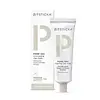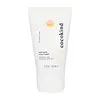What's inside
What's inside
 Key Ingredients
Key Ingredients

 Benefits
Benefits

 Concerns
Concerns

 Ingredients Side-by-side
Ingredients Side-by-side

Water
Skin ConditioningKaolin
AbrasiveBentonite
AbsorbentPropanediol
SolventAloe Barbadensis Leaf Juice
Skin ConditioningCetearyl Alcohol
EmollientTitanium Dioxide
Cosmetic ColorantOctyldodecanol
EmollientSulfur
AntiseborrhoeicGlyceryl Stearate
EmollientNiacinamide
SmoothingPolyglyceryl-10 Oleate
Skin ConditioningArginine
MaskingButylene Glycol
HumectantHydrolyzed Jojoba Esters
Skin Conditioning1,2-Hexanediol
Skin ConditioningCaprylyl Glycol
EmollientCitrus Aurantium Dulcis Peel Extract
Emulsion StabilisingMagnesium Aluminum Silicate
AbsorbentXanthan Gum
EmulsifyingLactic Acid
BufferingSalicylic Acid
MaskingAcacia Senegal Gum
MaskingDipotassium Glycyrrhizate
HumectantMenthyl Lactate
MaskingTetrasodium Glutamate Diacetate
Ricinus Communis Seed Oil
MaskingCI 77491
Cosmetic ColorantCI 77499
Cosmetic ColorantCI 77492
Cosmetic ColorantGlycerin
HumectantMalic Acid
BufferingTartaric Acid
BufferingChamomilla Recutita Flower Extract
MaskingRosa Canina Fruit Extract
AstringentAcetic Acid
BufferingPotassium Sorbate
PreservativeLeuconostoc/Radish Root Ferment Filtrate
AntimicrobialSodium Benzoate
MaskingWater, Kaolin, Bentonite, Propanediol, Aloe Barbadensis Leaf Juice, Cetearyl Alcohol, Titanium Dioxide, Octyldodecanol, Sulfur, Glyceryl Stearate, Niacinamide, Polyglyceryl-10 Oleate, Arginine, Butylene Glycol, Hydrolyzed Jojoba Esters, 1,2-Hexanediol, Caprylyl Glycol, Citrus Aurantium Dulcis Peel Extract, Magnesium Aluminum Silicate, Xanthan Gum, Lactic Acid, Salicylic Acid, Acacia Senegal Gum, Dipotassium Glycyrrhizate, Menthyl Lactate, Tetrasodium Glutamate Diacetate, Ricinus Communis Seed Oil, CI 77491, CI 77499, CI 77492, Glycerin, Malic Acid, Tartaric Acid, Chamomilla Recutita Flower Extract, Rosa Canina Fruit Extract, Acetic Acid, Potassium Sorbate, Leuconostoc/Radish Root Ferment Filtrate, Sodium Benzoate
Aloe Barbadensis Leaf Juice
Skin ConditioningSea Silt
Skin ConditioningBentonite
AbsorbentKaolin
AbrasiveGlycerin
HumectantHelianthus Annuus Seed Oil
EmollientStearyl Alcohol
EmollientCetearyl Alcohol
EmollientPersea Gratissima Oil
Skin ConditioningPhenethyl Alcohol
MaskingGlyceryl Stearate
EmollientCucumis Sativus Seed
ExfoliatingXanthan Gum
EmulsifyingCaprylic/Capric Triglyceride
MaskingTocopherol
AntioxidantSalvia Sclarea Oil
MaskingCetyl Phosphate
EmulsifyingSodium Dehydroacetate
PreservativeVegetable Oil
Skin ConditioningCaprylhydroxamic Acid
Quartz
AbrasiveCrambe Maritima Leaf Extract
Skin ConditioningAloe Barbadensis Leaf Juice, Sea Silt, Bentonite, Kaolin, Glycerin, Helianthus Annuus Seed Oil, Stearyl Alcohol, Cetearyl Alcohol, Persea Gratissima Oil, Phenethyl Alcohol, Glyceryl Stearate, Cucumis Sativus Seed, Xanthan Gum, Caprylic/Capric Triglyceride, Tocopherol, Salvia Sclarea Oil, Cetyl Phosphate, Sodium Dehydroacetate, Vegetable Oil, Caprylhydroxamic Acid, Quartz, Crambe Maritima Leaf Extract
 Reviews
Reviews

Ingredients Explained
These ingredients are found in both products.
Ingredients higher up in an ingredient list are typically present in a larger amount.
Aloe Barbadensis Leaf Juice comes from leaves of the aloe plant. Aloe Barbadensis Leaf Juice is best known for helping to soothe sunburns. It is also anti-inflammatory, moisturizing, antiseptic, and can help heal wounds.
Aloe is packed with good stuff including Vitamins A, C, and E. These vitamins are antioxidants, which help fight free-radicals and the damage they may cause. Free-radicals are molecules that may damage your skin cells, such as pollution.
Aloe Barbadensis Leaf Juice also contains sugars. These sugars come in the form of monosaccharides and polysaccharides, folic acid, and choline. These sugars are able to help bind moisture to skin.
It also contains minerals such as calcium, 12 anthraquinones, fatty acids, amino acids, and Vitamin B12.
Learn more about Aloe Barbadensis Leaf JuiceBentonite is an aluminium phyllosilicate clay with great absorbent properties. The name 'bentonite' comes from the area where the largest source is found: Fort Benton, Wyoming.
As a clay, bentonite is often used to absorb excess oil and provide exfoliation. It has also been shown to have some antibacterial and anti-inflammatory properties. Studies show bentonite was effective at calming dermatitis from poison ivy and in diaper dermatitis of infants. Bentonite has also been shown to act as a barrier against toxic compounds on your skin.
Sunscreens containing bentonite display higher water resistance and stay on the skin for much longer. The sunscreens containing bentonite also show higher potency and UV light absorbtion.
Bentonite is naturally created from volcanic ash and several natural weathering/hydrothermal processes.
A common usage of bentonite is removing excess protein from white wines. Bentonite contains a property of being able to absorb large amounts of protein from aqueous solutions.
Phyllosilicate clay has a structure formed by sheets.
Learn more about BentoniteCetearyl alcohol is a mixture of two fatty alcohols: cetyl alcohol and stearyl alcohol. It is mainly used as an emulsifier. Emulsifiers help prevent the separation of oils and products. Due to its composition, it can also be used to thicken a product or help create foam.
Cetearyl alcohol is an emollient. Emollients help soothe and hydrate the skin by trapping moisture.
Studies show Cetearyl alcohol is non-toxic and non-irritating. The FDA allows products labeled "alcohol-free" to have fatty alcohols.
This ingredient is usually derived from plant oils such as palm, vegetable, or coconut oils. There is debate on whether this ingredient will cause acne.
Due to the fatty acid base, this ingredient may not be Malassezia folliculitis safe.
Learn more about Cetearyl AlcoholGlycerin is already naturally found in your skin. It helps moisturize and protect your skin.
A study from 2016 found glycerin to be more effective as a humectant than AHAs and hyaluronic acid.
As a humectant, it helps the skin stay hydrated by pulling moisture to your skin. The low molecular weight of glycerin allows it to pull moisture into the deeper layers of your skin.
Hydrated skin improves your skin barrier; Your skin barrier helps protect against irritants and bacteria.
Glycerin has also been found to have antimicrobial and antiviral properties. Due to these properties, glycerin is often used in wound and burn treatments.
In cosmetics, glycerin is usually derived from plants such as soybean or palm. However, it can also be sourced from animals, such as tallow or animal fat.
This ingredient is organic, colorless, odorless, and non-toxic.
Glycerin is the name for this ingredient in American English. British English uses Glycerol/Glycerine.
Learn more about GlycerinGlyceryl Stearate is a mix of glycerin and stearic acid.
It is used to stabilize the mixing of water and oil ingredients. By preventing these ingredients from separating, it can help elongate shelf life. It can also help thicken the product's texture.
As an emollient, it helps soften skin and supports barrier-replenishing ingredients.
In cosmetics, Glyceryl Stearate is often made from vegetable oils or synthetically produced.
This ingredient may not be fungal-acne safe
Fun fact: The human body also creates Glyceryl Stearate naturally.
Learn more about Glyceryl StearateKaolin is a clay. It is used for oil control and to help minimize pores. Like other clays, kaolin has the ability to absorb excess sebum or oil. This can help clean out pores and mattify the skin.
Some types of kaolin may have exfoliating properties. When water is added to kaolin, it becomes a paste with small abrasive particles.
Most kaolin is a white color, but may be pink/orange/red depending on where it comes from.
The name 'kaolin' comes from a Chinese village named 'Gaoling'. Kaolin clay comes from rocks rich in kaolinite. Kaolinite, the mineral, has a silicate layered structure. Kaolinite is formed from chemical weathering of aluminum siilicate minerals.
Besides skincare, kaolin is commonly used to make glossy paper, in ceramics, toothpaste, and as medicine to soothe stomach issues.
Learn more about KaolinXanthan gum is used as a stabilizer and thickener within cosmetic products. It helps give products a sticky, thick feeling - preventing them from being too runny.
On the technical side of things, xanthan gum is a polysaccharide - a combination consisting of multiple sugar molecules bonded together.
Xanthan gum is a pretty common and great ingredient. It is a natural, non-toxic, non-irritating ingredient that is also commonly used in food products.
Learn more about Xanthan Gum